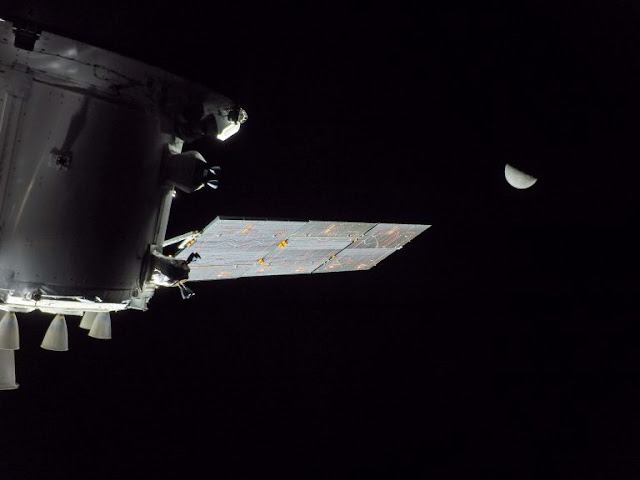EVA - Extra Vehicular Activities patch.
Dec 3, 2022
Expedition 68 Flight Engineers Josh Cassada and Frank Rubio of NASA concluded their spacewalk at 2:21 p.m. EST after 7 hours and 5 minutes.
Image above: Astronauts (from left) Josh Cassada and Frank Rubio are pictured suited up in their spacesuits preparing for a spacewalk on Nov. 15, 2022. Image Credit: NASA.
Cassada and Rubio completed their major objectives for today to install an International Space Station Roll-Out Solar Array (iROSA) and disconnect a cable to ensure the 1B channel can be reactivated. They also completed an additional task to release several bolts for the upcoming iROSA installation on the 4A power channel on the port truss.
Image above: Astronaut Josh Cassada is pictured during a spacewalk on Nov. 15, 2022, to ready the space station for future rollout solar array installation work. Image Credit: NASA TV.
It was the 256th spacewalk in support of space station assembly, upgrades and maintenance, and was the second spacewalk for both astronauts. Cassada and Rubio are in the midst of a planned six-month science mission living and working aboard the microgravity laboratory to advance scientific knowledge and demonstrate new technologies for future human and robotic exploration missions, including lunar missions through NASA’s Artemis program.
Image above: NASA spacewalker Josh Cassada rides the Canadarm2 robotic arm carrying the roll-out solar array to its installation site on the Starboard-4 truss segment. Image Credit: NASA TV.
The next U.S. spacewalk is scheduled for Monday, Dec. 19, to install an iROSA on the 4A power channel on the port truss. This will be the fourth iROSAs out of a total six planned for installation. The iROSAs will increase power generation capability by up to 30%, increasing the station’s total available power from 160 kilowatts to up to 215 kilowatts.
Related links:
Expedition 68: https://www.nasa.gov/mission_pages/station/expeditions/expedition68/index.html
Quest airlock: https://www.nasa.gov/mission_pages/station/structure/elements/joint-quest-airlock
Starboard- 4 truss segment: https://www.nasa.gov/mission_pages/station/structure/elements/truss-structure
Canadarm2 robotic arm: https://www.nasa.gov/mission_pages/station/structure/elements/mobile-servicing-system.html
International Space Station (ISS): https://www.nasa.gov/mission_pages/station/main/index.html
Images (mentioned), Text, Credits: NASA/Mark Garcia.
Best regards, Orbiter.ch




























_01.png)












